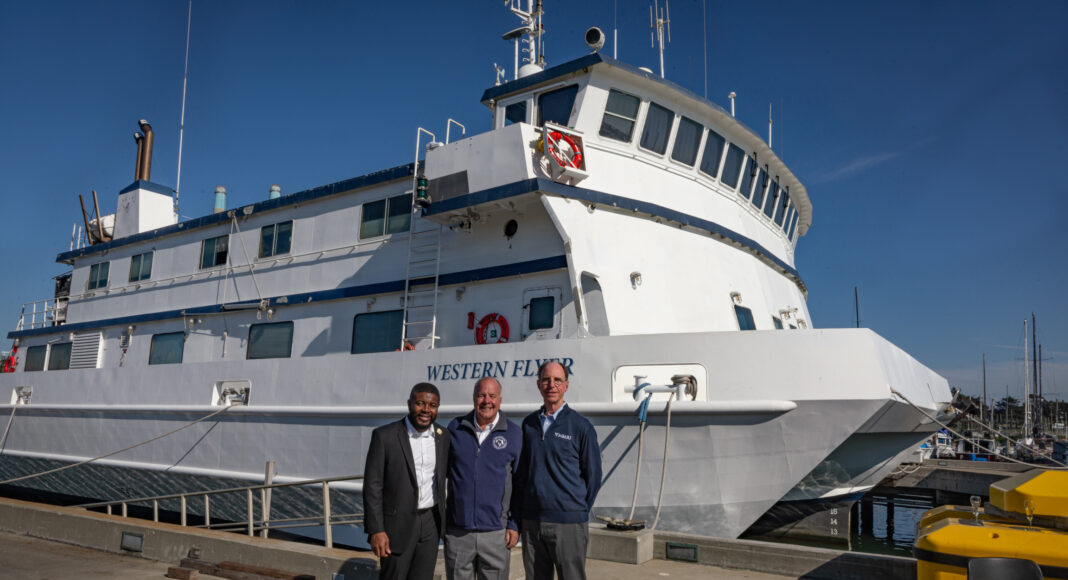Most of the deep sea is still shrouded in mystery—hidden beneath inky, icy, high-pressure water. But much of what we do know comes from the efforts of a few specialized research institutes, including the Monterey Bay Aquarium Research Institute.
Situated in Moss Landing at the mouth of the underwater Monterey Canyon, MBARI has spent the last 35 years exploring the deep. As part of a new chapter, the institute recently said goodbye to its largest research vessel, the R/V Western Flyer, to make way for a new ship.
Built in 1996, the Western Flyer made more than 500 research cruises around Monterey Bay and beyond, and helped researchers identify more than 200 new species. The ship completed its last MBARI mission on October 6—but just like the organization itself, the Western Flyer is about to begin a new chapter: it will now serve as a sailing classroom for the Florida Institute of Oceanography.
“At one point, things looked kind of bleak—like we were going to have to recycle the ship,” says Mike Kelly, MBARI’s director of marine operations. “And then we heard of FIO’s interest in procuring a new ship, and we started discussions and it went from there.”
The ship will sail through the Panama Canal to Florida, likely arriving in the spring.
“We expect to be operational in the summer, taking cohorts of students out and working on some projects that are most likely tied around marine archaeology and exploration and technology, and using those as a way to kick off,” says Monty Graham, the director of the Florida Institute of Oceanography.
The new FIO program will focus specifically on engaging nearby historically marginalized communities.
“It’s more than just training scientists,” says Graham. The program will involve all aspects of operating a ship, including crews, shore support and supply chain connections.
“A program core element is co-creation, meaning that we want the community to have very much a voice in what is happening in science,” says Qu’Derrick Covington, the DEI program director at FIO.
“We want to make sure that these diverse communities have representation, but not just representation: that they also have a level of confidence in their community, amongst each other, to come back with those solutions.”
Age of Autonomy
After the departure of the Western Flyer, MBARI will await its new vessel, the R/V David Packard, which is currently under construction at Freire’s shipyard in Spain. Named for the institute’s founder, the new David Packard will be 164-by-42 feet wide, with the capacity for 30 people. It’s expected to set sail next summer.
Unlike the twin-hull Western Flyer, the new R/V David Packard is a monohull shape. While this provides less stability, the new ship will offer more outside deck space. Kelly says this change reflects a larger shift at MBARI. Scientists are increasingly using ships to deploy autonomous underwater vehicles (AUVs).
The Western Flyer served primarily as a stable platform for deploying a remotely operated vehicle (ROV)—an underwater robot tethered to the ship by a long cable and operated by a pilot on board. MBARI’s ROV Doc Ricketts can dive almost two and a half miles below the surface.
The institute will still use the new ship for the Doc Ricketts, but AUVs offer new exciting ways to explore the deep. These robots can travel several hundred miles after launching, collecting images, water samples and measurements as they go.
In order to continue developing new technologies like AUVs, MBARI will soon build a new robotic technology lab: the Instrumentation Integration and Testing Facility. The two-story, 31,900-square-foot building will take shape across the street from the institute’s dock, at the former location of Phil’s Fish Market and Eatery. Phil’s relocated three miles away to a historic schoolhouse building in Castroville.
The new technology lab and a new Expedition Staging Building will be the first new buildings at MBARI in over 20 years. Researchers will use the new staging building to prepare equipment for expeditions beyond Monterey Bay, such as Arctic trips. With new technology, new space and a shiny new ship, MBARI’s sails are set for discovery.













